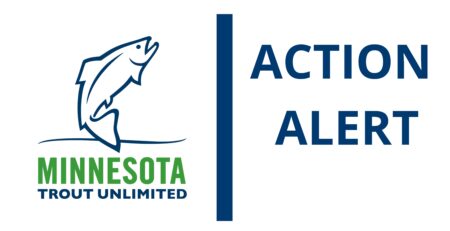Public Waters Under Threat… again
April 21, 2025
The Senate Environment Budget bill (SF2077) contains a provision that will make it less clear which streams and headwater tributaries are protected under state law as “public waters”, by repealing a clarification adopted by the Legislature in 2024. The Minnesota Senate should remove this provision to ensure all public waters are protected.
In Minnesota, waters are owned by the public and held in trust by the State. The State defined what is a “public water” in statute. It also instructed the DNR to develop a list and maps of all public waters called the Public Waters Inventory (PWI). The lists and maps were created in the early 1980s, but errors were made due to limits in the technology used at that time. Some public waters did not make it onto the PWI, and others were dropped due to procedural errors. Many of the waters left off the PWI are small headwater streams and trout stream tributaries, that are important for water quality and the health of fisheries downstream. The DNR has always correctly interpreted the law to mean that any stream meeting the definition is a “public water”, whether or not it is listed on the error-prone PWI. Buts disputes with those proposing to harm public waters not on the PWI led to lawsuits. The Minnesota Supreme Court agreed with the DNR that small streams that meet the definition are “public waters”, whether or not listed on the PWI. The Court urged the Legislature to clarify the statute.
In 2024, the Minnesota Legislature adopted language clarifying that the statutory definition (not the PWI) defines the scope of the State’s jurisdiction over public waters, reinforcing the DNR’s and Court’s interpretation. It also gave DNR $8 Million to begin updating the old maps and lists. The provision in SF2077 would repeal the clarification adopted in 2024, returning to unnecessary ambiguity and lawsuits.
Minnesota’s state laws protecting public waters, including small headwater streams and trout stream tributaries, are particularly important right now. The federal government is limiting which waterways are protected by federal law, and instructing agencies like the Environmental Protection Agency and the U.S. Army Corps of Engineers to approve permits that do not protect public waters. What Minnesota protects with state laws is what will be protected – there is no federal safety net. That’s why clarity about what streams, rivers, wetlands and lakes are covered under state law is needed now, more than ever. Ensuring current state protection is not rolled back is important for protecting our trout streams today and for future generations.
To ensure that all public waters in Minnesota are protected, it is critical to preserve the clarifying language adopted by the Minnesota Legislature in 2024 and OPPOSE the rollback in SF2077.
Join us in standing up for public waters and the public benefits they provide. Tell your legislators to oppose efforts to muddy the waters about which streams, rivers and lakes are protected under state laws.
Find your State Senator’s contact information here.
Tell them:
- I am a trout angler from [insert town], Minnesota and I am concerned that public waters, including many trout streams, in Minnesota will not receive the protections they should if the rollback of the 2024 clarification of public waters in SF2077 is adopted.
- I OPPOSE the rollback of the 2024 clarification of public waters included in SF2077 because it introduces unnecessary ambiguity into the public waters statute, which the Legislature fixed just last year.
- When Minnesota became a state, its waters were transferred to the state government to be held in trust for its citizens. And in Minnesota, where water is central to our identity, the legislature has taken an expansive view of what counts as a public water. That view is expressed in the statutory definition that was reaffirmed last year.
- Thank you for ensuring protection of our trout streams today and for future generations by OPPOSING the rollback of the 2024 clarification of public waters in SF2077.

